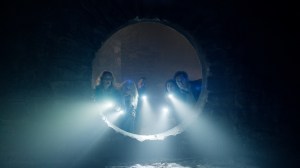
Robert Sikoryak’s previous pastiche-focused work, Terms and Conditions, read like a grand gag where the joke was the unread document illustrated in more than 100 different, comics-influenced styles. He applies that same approach in Constitution Illustrated, but the effect is very different given the source material at its center. While current events may bring into question how many Americans are actually familiar with the document, the significance and impact of the U.S. Constitution is undeniable. Unlike Apple’s endless scroll of terminology which is updated several times each year, these words are much more difficult to change and they define the rules of governance for hundreds of millions of people. That shift in subject matter alone makes Constitution Illustrated feel more substantial at first glance, providing a document and artwork to be reviewed even after the novelty wears thin.
Videos by ComicBook.com

The work’s printed form appears to acknowledge the reference value of what is being presented. A trim volume with an introductory index and well-organized endnotes makes the source material easy to navigate for any reader seeking to cite how the executive is actually defined or curious to simply check the phrasing within the Bill of Rights. It would rest almost as easily on a desk or bookshelf as the many editions containing only language. Sikoryak’s choice of subject and wide array of styles accompanying those words is what sets Constitution Illustrated apart, however.
Sikoryak’s skill extends beyond simple imitation here. Each artist homaged in these pages does not receive the most obvious duplication of recognizable efforts. Style and characters alike are translated by Sikoryak to meet the tone of the text. Jack Kirby’s Fantastic Four offers the inspiration for an illustration of the Tenth Amendment, which devolves unnamed powers to the states. The Thing, Medusa, and many others are present with poses and expressions that feel true to Kirby even as they are dressed in colonial costumes. Krackle spatters the space above their heads and characters thrust their fists and fingers forward—all serving to capture the dynamism of Kirby’s work in an original composition.

The expansive nature of that amendment offers a neat, but minor connection between the text and its paired illustration. However, there are many pieces within Constitution Illustrated that demand greater meaning in the juxtaposition of words and text. The preamble, perhaps the most utopian and quoted part of the Constitution, is served well with the innocent faces found in Raina Telgemeier’s work; it provides a clear sense of patriotism that defines the text’s appreciation of this document.
That patriotism is carried into more difficult places that force a confrontation between the ideal of America and its historical reality. The Thirteenth Amendment displays Luke Cage, in the style of Billy Graham, shattering his chains to commemorate the abolishment of slavery. On its face this serves as a celebration of this particular piece of progress, while language of the Three-Fifths Compromise redacted in the Fourteenth Amendment is left unheralded in the notes section at the end of the comic. Comics historians are likely to best perceive and address the commentary embedded in Sikoryak’s choices. The use of Graham’s style as one of superhero comics earliest Black illustrators highlights the work of a significant and sadly overlooked barrier-breaker in comics to accompany this celebratory tone.

Considering the choices made on each page offers a satisfying puzzle for those familiar with both the medium and document they are reviewing. However, the text offers little support to aid readers in this work. This limits its ability to engage readers beyond an audience of comics fans who care deeply about the American government. For many, the illustrations will serve primarily as an enjoyable game to spot familiar elements. This may limit the value of Constitution Illustrated as an educational tool or historical document, but it does not diminish the essential form of the comic. It remains a useful reference for an essential text—the modern importance of which is being shown daily in news of federal failures and American uprisings—and it brings a sense of joy and curiosity that encourages readers to keep turning pages. There’s value in that sort of accessibility and enticement, especially when paired with something that can truly be said to belong on every American’s bookshelf.
Published by Drawn and Quarterly
On July 28, 2020
Created by R. Sikoryak








